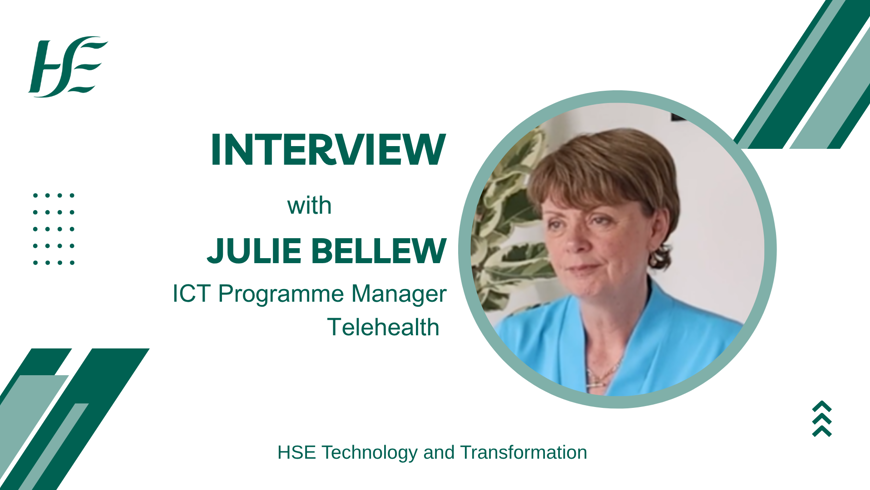
Transforming Care: Reflecting on a Career in Digital Health
By Julie Bellew , Former ICT Programme Manager for Telehealth, Health Service Executive
After nearly three decades in the health service, retirement has given me time to reflect on what has mattered most throughout my career. Without hesitation, the answer is simple: the people. The colleagues I worked alongside, the teams I had the privilege to lead, and most importantly the patients and service users who remind us daily why this work is so vital.
Building the Foundations
Over the years, I was fortunate to contribute to many projects, beginning in the North East with projects such as the front end deployment of SAP Financials, iPMS (Patient Administration System) and Lotus Notes email. Introducing Citrix for the first time transformed services from using ‘dumb’ terminals to a modern Windows-based environment a foundational step for everything that followed.
Providing local IT support in County Louth for many years was a true labour of love for this Dundalk girl. It helped establish ICT as a valued part of the multidisciplinary team, providing support when and where it was needed and laying the groundwork for future progress. Later, for more than a decade, I served as ICT Applications Lead on NIMIS, the National Integrated Medical Imaging System our largest and most successful national digital health project to date. This brought a national aspect to my work.
In more recent years, my focus shifted to Telehealth, Video-Enabled Care, Virtual Wards, and plans for a national Centre of Excellence work that brought my career full circle.
From Necessity to Choice: The Evolution of Telehealth
During the COVID-19 pandemic, Telehealth became a lifeline, ensuring care continued while keeping patients and staff safe. Even before then, we had begun exploring video-enabled care and remote monitoring through EU-funded Co-operation and Working Together (CAWT) collaborations.
Today, Telehealth is no longer a fall-back it’s a tool of choice. Clinicians nationwide are embracing it to enhance care in new and innovative ways, enabling patients to receive support at a place that they call home. Feedback has been overwhelmingly positive.
Unlike many health technologies, Telehealth is used by both staff and patients alike, which makes accessibility, usability, and digital inclusiveness essential. No matter where someone lives or how comfortable they are with technology, they should be able to access quality care remotely. We have worked hard to make that possible.
Virtual Wards: Redefining Acute Care at Home
Among the most transformative developments has been the introduction of Virtual Wards. Inspired by examples in the UK, my team, working with the Digital Health Clinical Office, proposed the idea in late 2022. By mid-2024, with very hard work, leadership from the Office of the Chief Clinical Officer and high levels of clinical, service and technical collaboration both nationally and locally, the first two virtual wards went live.
These virtual wards allow patients who still need acute care to recover at home while being monitored remotely by a dedicated hospital-based team. The benefits are broad and significant: fewer hospital-acquired infections, reduced deconditioning, faster recovery times and improved patient flow, with this extended capacity positively impacting on emergency departments. Patients feel safe and are more comfortable at home, while their hospital bed is available to other patients.
The impact goes further still: studies show major reductions in travel, associated carbon emissions, and overall healthcare costs. A virtual ward “bed day” has been shown to emit up to four times less CO₂ than a hospital bed day, making this not just a clinical innovation but an environmental one.
Most importantly, patient voices remind us what this truly means. Stories like Tommy’s in Limerick who experienced the Virtual Ward (video) and Celene Garvey who was supported through Video calls (video), providing dignity, safety, choice, and the comfort of being where you belong—at home.
The Next Phase: A Centre of Excellence for Telehealth
To ensure Telehealth continues to grow in a structured, scalable way a framework to establish a national Telehealth Centre of Excellence is in its final stages. This model will act as the delivery mechanism for the Telehealth Roadmap published in December 2022; Co-designed with the Digital health Clinical office and the Telehealth community, it will provide a one-stop shop on all aspects of Telehealth for teams around the country.
I think of it as a supermarket. Some services may just need specific tools: a video licence, a monitoring guide or a training module for example. Others may need advice, signposting or hands-on project support. The CoE will bring together clinical, technical, and operational colleagues to provide that support and access to expertise in one accessible place. Larger national projects will also be run from within the CoE.
